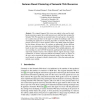WS
2008
ACM
14 years 5 months ago
2008
ACM
Semantic Web applications share a large portion of development effort with database-driven Web applications. Existing approaches for development of these database-driven applicati...
IJMSO
2006
14 years 5 months ago
2006
: On the semantic web, assertions may be aggregated from many sources, those aggregations filtered, reasoned over, aggregated with other aggregators, displayed, scraped, extracted,...
HPDC
2010
IEEE
14 years 6 months ago
2010
IEEE
The Semantic Web consists of many billions of statements made of terms that are either URIs or literals. Since these terms usually consist of long sequences of characters, an effe...
LREC
2010
14 years 6 months ago
2010
After several years of development, the vision of the Semantic Web is gradually becoming reality. Large data repositories have been created and offer semantic information in a mac...
CIDR
2007
14 years 6 months ago
2007
While it is generally accepted that data warehouses and OLAP workloads are excellent applications for column-stores, this paper speculates that column-stores may well be suited fo...
BIS
2010
14 years 6 months ago
2010
The quality of data is a key factor that determines the performance of information systems, in particular with regard (1) to the amount of exceptions in the execution of business p...
ESWS
2008
Springer
14 years 7 months ago
2008
Springer
Exploiting the complex structure of relational data enables to build better models by taking into account the additional information provided by the links between objects. We exten...
ESWS
2008
Springer
14 years 7 months ago
2008
Springer
Abstract. The original Semantic Web vision was explicit in the need for intelligent autonomous agents that would represent users and help them navigate the Semantic Web. We argue t...
SAC
2009
ACM
14 years 10 months ago
2009
ACM
The Semantic Web and its technologies become increasingly important. As more and more Semantic Web applications are being used, developing more stable Semantic Web applications be...
SOFTVIS
2006
ACM
14 years 11 months ago
2006
ACM
Visual paradigms such as node-link diagrams are well suited to the representation of Semantic Web data encoded with the Resource Description Framework (RDF), whose data model can ...






